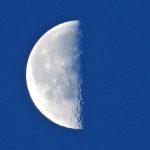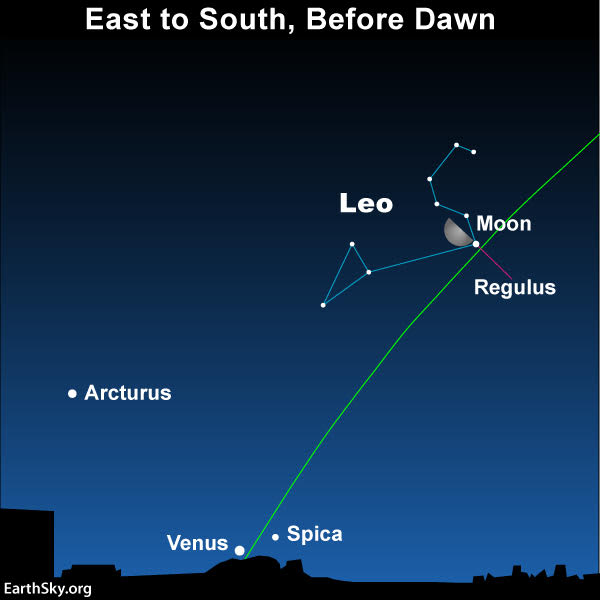
The moon was almost exactly at last quarter when Deirdre Horan in Dublin, Ireland, captured this photo. The terminator line, or line between light and dark on the moon, appears straight.
A last quarter moon appears half-lit by sunshine and half-immersed in its own shadow. It rises in the middle of the night, appears at its highest in the sky around dawn, and sets around midday. The moon reaches its exact half-illuminated phase, as viewed from Earth, on November 30, 2018, at 00:19 UTC; translate UTC to your time.
On a last quarter moon, the lunar terminator – the shadow line dividing day and night – shows you where it’s sunset on the moon.
The 2019 lunar calendars are here! Order yours before they’re gone. Makes a great gift.

The night before last quarter moon – on November 28, 2018 – the moon is near the bright star Regulus, Heart of the Lion in Leo. Day by day, before dawn, watch for the waning moon to sink toward Venus and to meet up with this dazzling world in early December, 2018.
A last quarter moon provides a great opportunity to think of yourself on a three-dimensional world in space. For example, it’s fun to see this moon just after moonrise, shortly after midnight. Then the lighted portion points downward, to the sun below your feet. Think of the last quarter moon as a mirror to the world you’re standing on. Think of yourself standing in the middle of Earth’s nightside, on the midnight portion of Earth.
Also, a last quarter moon can be used as a guidepost to Earth’s direction of motion in orbit around the sun.
In other words, when you look toward a last quarter moon high in the predawn sky, for example, you’re gazing out approximately along the path of Earth’s orbit, in a forward direction. The moon is moving in orbit around the sun with the Earth and never holds still. But, if we could somehow anchor the moon in space … tie it down, keep it still … Earth’s orbital speed of 18 miles per second would carry us across the space between us and the moon in only a few hours.
Want to read more about the last quarter moon as a guidepost for Earth’s motion? Astronomer Guy Ottewell talked about it recently, too.
A great thing about using the moon as a guidepost to Earth’s motion is that you can do it anywhere … as, for example, in the photo below, from large cities.
Ben Orlove wrote from New York City: “I was sitting in the roof garden of my building, and there was the moon, right in front of me. You were right, this is a perfect time to visualize … the Earth’s motion.”
As the moon orbits Earth, it changes phase in an orderly way. Follow the links below to understand the phases of the moon.
New moon
Waxing crescent moon
First quarter moon
Waxing gibbous moon
Full moon
Waning gibbous moon
Last quarter moon
Waning crescent moon
Read more: 4 keys to understanding moon phases
Bottom line: The next last quarter moon falls on November 30, 2018 at 00:19 UTC; translate UTC to your time.
from EarthSky https://ift.tt/2ze0n1D

The moon was almost exactly at last quarter when Deirdre Horan in Dublin, Ireland, captured this photo. The terminator line, or line between light and dark on the moon, appears straight.
A last quarter moon appears half-lit by sunshine and half-immersed in its own shadow. It rises in the middle of the night, appears at its highest in the sky around dawn, and sets around midday. The moon reaches its exact half-illuminated phase, as viewed from Earth, on November 30, 2018, at 00:19 UTC; translate UTC to your time.
On a last quarter moon, the lunar terminator – the shadow line dividing day and night – shows you where it’s sunset on the moon.
The 2019 lunar calendars are here! Order yours before they’re gone. Makes a great gift.

The night before last quarter moon – on November 28, 2018 – the moon is near the bright star Regulus, Heart of the Lion in Leo. Day by day, before dawn, watch for the waning moon to sink toward Venus and to meet up with this dazzling world in early December, 2018.
A last quarter moon provides a great opportunity to think of yourself on a three-dimensional world in space. For example, it’s fun to see this moon just after moonrise, shortly after midnight. Then the lighted portion points downward, to the sun below your feet. Think of the last quarter moon as a mirror to the world you’re standing on. Think of yourself standing in the middle of Earth’s nightside, on the midnight portion of Earth.
Also, a last quarter moon can be used as a guidepost to Earth’s direction of motion in orbit around the sun.
In other words, when you look toward a last quarter moon high in the predawn sky, for example, you’re gazing out approximately along the path of Earth’s orbit, in a forward direction. The moon is moving in orbit around the sun with the Earth and never holds still. But, if we could somehow anchor the moon in space … tie it down, keep it still … Earth’s orbital speed of 18 miles per second would carry us across the space between us and the moon in only a few hours.
Want to read more about the last quarter moon as a guidepost for Earth’s motion? Astronomer Guy Ottewell talked about it recently, too.
A great thing about using the moon as a guidepost to Earth’s motion is that you can do it anywhere … as, for example, in the photo below, from large cities.
Ben Orlove wrote from New York City: “I was sitting in the roof garden of my building, and there was the moon, right in front of me. You were right, this is a perfect time to visualize … the Earth’s motion.”
As the moon orbits Earth, it changes phase in an orderly way. Follow the links below to understand the phases of the moon.
New moon
Waxing crescent moon
First quarter moon
Waxing gibbous moon
Full moon
Waning gibbous moon
Last quarter moon
Waning crescent moon
Read more: 4 keys to understanding moon phases
Bottom line: The next last quarter moon falls on November 30, 2018 at 00:19 UTC; translate UTC to your time.
from EarthSky https://ift.tt/2ze0n1D

Aucun commentaire:
Enregistrer un commentaire